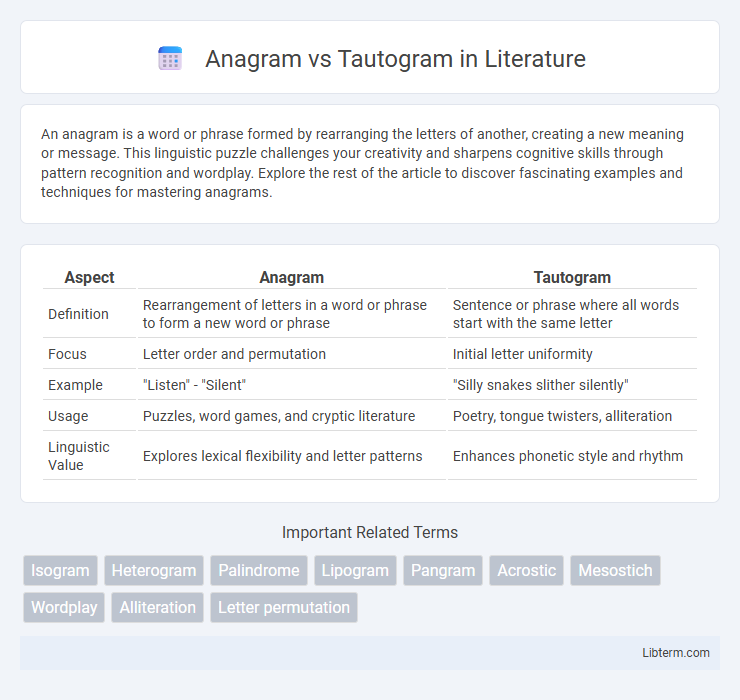An anagram is a word or phrase formed by rearranging the letters of another, creating a new meaning or message. This linguistic puzzle challenges your creativity and sharpens cognitive skills through pattern recognition and wordplay. Explore the rest of the article to discover fascinating examples and techniques for mastering anagrams.
Table of Comparison
| Aspect | Anagram | Tautogram |
|---|---|---|
| Definition | Rearrangement of letters in a word or phrase to form a new word or phrase | Sentence or phrase where all words start with the same letter |
| Focus | Letter order and permutation | Initial letter uniformity |
| Example | "Listen" - "Silent" | "Silly snakes slither silently" |
| Usage | Puzzles, word games, and cryptic literature | Poetry, tongue twisters, alliteration |
| Linguistic Value | Explores lexical flexibility and letter patterns | Enhances phonetic style and rhythm |
Understanding Anagrams: Definition and Examples
Anagrams are words or phrases formed by rearranging the letters of another word or phrase, often creating a meaningful or related term. For example, "listen" can be rearranged to form "silent," demonstrating the playful nature of anagrams in language. Unlike tautograms, which emphasize initial letter repetition, anagrams focus on letter arrangement to explore linguistic creativity and word relationships.
Exploring Tautograms: Meaning and Illustrations
Tautograms are linguistic devices where every word in a phrase or sentence begins with the same letter, creating a rhythmic and memorable pattern. This poetic technique enhances alliteration and phonetic harmony, often used in tongue twisters and mnemonic aids. Examples like "Sally sells seashells by the seashore" illustrate how tautograms blend sound and meaning for artistic and cognitive impact.
Historical Origins of Anagrams and Tautograms
Anagrams, with origins tracing back to ancient Greece, were initially used as mystical tools and employed by poets and scholars for wordplay and secrecy. Tautograms, rooted in medieval Latin literature and oral traditions, emerged as a stylistic device where every word begins with the same letter, serving mnemonic and artistic purposes. Both anagrams and tautograms evolved through centuries, reflecting cultural and linguistic creativity across classical and medieval periods.
Structural Differences Between Anagrams and Tautograms
Anagrams involve rearranging the letters of a word or phrase to create a new word or phrase, focusing on letter composition and order. Tautograms emphasize the repetition of initial letters across multiple words in a phrase or sentence, highlighting phonetic and structural uniformity. While anagrams prioritize letter permutation at the micro level, tautograms maintain consistent starting letters at the macro level of word arrangement.
Creative Uses in Literature: Anagram vs Tautogram
Anagrams rearrange letters of words or phrases to reveal hidden meanings or character connections, making them a powerful tool in literature for wordplay and thematic depth. Tautograms, which repeat the same initial letter in consecutive words, create rhythmic and phonetic patterns that enhance the mood and memorability of poetic or narrative passages. Both techniques stimulate reader engagement by adding layers of linguistic creativity and interpretive challenge within literary works.
Cognitive Benefits: Brain-Boosting Puzzles
Anagrams and tautograms stimulate cognitive functions by engaging different linguistic and memory skills, enhancing mental agility and vocabulary recall. Anagrams challenge the brain's pattern recognition and problem-solving abilities through letter rearrangement, while tautograms exercise alliteration processing and phonological awareness. Both puzzles improve concentration, working memory, and lexical retrieval, contributing to overall brain health and language proficiency.
Common Challenges in Crafting Anagrams and Tautograms
Crafting anagrams and tautograms presents unique linguistic challenges, such as maintaining meaningful content while adhering to strict letter or sound constraints. Anagram creation demands precise letter rearrangement without losing semantic coherence, often limiting vocabulary choices. Tautograms require careful selection of words beginning with the same letter, which can restrict expression and complicate sentence structure.
Famous Anagrams and Tautograms in Popular Culture
Famous anagrams in popular culture include "Tom Marvolo Riddle," which rearranges to "I am Lord Voldemort" from the Harry Potter series, showcasing clever wordplay that enhances character mystique. Tautograms feature prominently in poetry and branding, such as Edgar Allan Poe's poem "The Raven," where the repeated initial consonants create a haunting effect. Both anagrams and tautograms are celebrated for their linguistic creativity and memorable impact across literature, film, and advertising.
Tips for Creating Effective Anagrams and Tautograms
Effective anagrams require focusing on letter frequency and flexibility, carefully rearranging letters to form meaningful words or phrases while maintaining balance and coherence. For tautograms, prioritize selecting consistent initial letters and crafting phrases where each word starts with the same letter to enhance memorability and poetic rhythm. Using word lists and brainstorming tools can streamline the creative process for both anagrams and tautograms, ensuring clarity and impact.
Key Takeaways: Distinguishing Anagrams from Tautograms
Anagrams involve rearranging the letters of a word or phrase to create a new word or phrase using all original letters exactly once, while tautograms consist of words in a sentence or phrase that all start with the same initial letter. Key distinctions include letter rearrangement in anagrams versus consistent initial letters in tautograms, making them fundamentally different linguistic constructs. Understanding these differences enhances clarity in wordplay, literary analysis, and language learning.
Anagram Infographic

 libterm.com
libterm.com